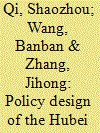|
|
|
Sort Order |
|
|
|
Items / Page
|
|
|
|
|
|
|
| Srl | Item |
| 1 |
ID:
136190


|
|
|
|
|
| Summary/Abstract |
Of seven pilot emissions trading schemes (ETS) being run in China, the ETS in Hubei province is the only provincial pilot in the central and western regions of the country with a high GDP growth rate and heavy industrial structure. As such, it is quite representative of China as a whole and its ETS will therefore be reasonably characteristic of a future nationwide market. This paper describes the policy design of the Hubei ETS, including aspects of coverage, cap, allowance allocation, transactions, compliance and penalties. Then, after making a comparison with the other Chinese pilots and emissions trading schemes in the European Union (EU) and California, the paper offers a summary of several distinct features of the Hubei ETS. First, the small numbers of entities that are covered by the scheme produce a considerable proportion of the emissions. This makes Hubei the world׳s third largest carbon market. Second, the Hubei ETS applies several mechanisms to deal with the province’s rapid growth rate. Third, the scheme׳s policy design emphasizes liquidity. In addition to these unique features, the Hubei ETS also shares some common features with all the pilots in China.
|
|
|
|
|
|
|
|
|
|
|
|
|
|
|
|
| 2 |
ID:
186428


|
|
|
|
|
| Summary/Abstract |
We evaluated whether China's overseas investments in energy infrastructure were dirtier or cleaner after the Belt and Road Initiative than those of other countries with similar project and host country characteristics. We used the energy infrastructure project data from the World Bank's private participation in infrastructure database, which allows comparison among countries of investment and controls for the influences of host countries' demand. Our main findings are as follows. First, during our sample period from 2006 to 2019, the average investment volume of projects funded by China was significantly higher overall including in conventional energy projects, compared to those with other financial sources and similar features. Second, after the Belt and Road Initiative (BRI), the volume of projects invested in by China was comparatively smaller in conventional energy projects but larger in renewable energy projects. Third, the choice of technology type in energy projects reflected path dependency effects on both the investment and host countries' sides. Nevertheless, after the Belt and Road Initiative, China had actively begun to break away from these effects, investing more in clean energy overseas.
|
|
|
|
|
|
|
|
|
|
|
|
|
|
|
|
|
|
|
|
|